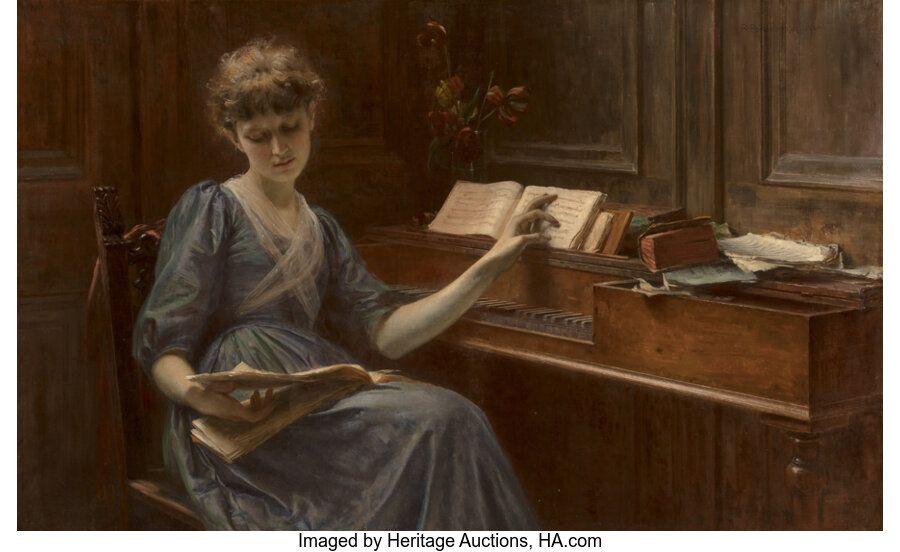Description
Robert Poetzelberger (Austrian, 1856-1930) Alte Leider (Old Songs), circa 1887-1890 Oil on canvas 32 x 51-1/2 inches ...
Robert Poetzelberger (Austrian, 1856-1930) Alte Leider (Old Songs), circa 1887-1890 Oil on canvas 32 x 51-1/2 inches (81.3 x 130.8 cm) Signed and inscribed upper right: R. Poetzelberger -Mchn- PROVENANCE: Collection of Mr. and Mrs. William Pulsifer, Naples, Florida; Private collection, Fort Myers, Florida. Viennese artist Robert Poetzelberger enjoyed a distinguished career as a painter, sculptor, printmaker and art professor in several of Germany's major artistic centers. After completing his education at the Academy of Fine Arts in Vienna (1874-1878), he toured Italy in 1879, joining Munich's Academy of Fine Arts the following year. During his twelve-year tenure in Munich (until 1892), Poetzelberger fell profoundly under the influence of fellow academician Ludwig von Löfftz, the noted genre and landscape painter from Darmstadt. In Munich Poetzelberger became a superb draftsman and developed, in emulation of Löfftz, a masterful chiaroscuro which imbues his Munich achievements with a delicate sense of atmosphere and serenity—qualities on full display in the present work, Alte Lieder (Old Songs). In 1892, Poetzelberger moved to Karlsruhe where he assumed a professorship at the Grand Ducal Baden Art School until 1899, and where his work shifted to an Impressionistic palette with freer brushwork. He also gravitated increasingly towards landscape, a trend that continued for the rest of his life. In 1899, he accepted the third professorship of his career, at the Stuttgart Art School, where he was appointed successor to Ludwig Herterich, and remained until his retirement in 1926. Poetzelberger was a member of the German Association of Artists and, in 1898, co-founder of the Karlsruhe Association of Artists. In 1904 he designed a sculptural Pietà for the family tomb of the industrialist Hagenbucher family in Heilbronn, Germany. His son Oswald Poetzelberger was also a painter. Over the course of a successful career marked by commissions, major professorships, and a long roster of students, Robert Poetzelberger achieved his greatest artistic recognition for a corpus of genre paintings that feature musicians making music, either alone or together at the spinet—a particularly apt subject for a painter born into the epicenter of music production during the Romantic period. The present work, Alte Leider, is the largest-known example of these exquisite musical subjects, which the artist painted in Munich circa 1887-1890. Although the present whereabouts of most of Poetzelberger's music paintings are unknown, we fortunately have a good record of their appearance through the fine quality etchings, lithographs and photogravures made after them during the artist's lifetime. By arranging for them to be reproduced as prints, Poetzelberger adopted a strategy for publicizing his artwork to a vastly wider audience. Alte Leider was engraved and reproduced as an illustration for the magazine, The Graphic, December 6, 1890. Poetzelberger's composition entitled The Prelude (1887), for example, depicting a handsome violinist seated beside a young woman at the spinet while gazing at her adoringly, is known through an etching preserved in the British Museum (inv. no. 1920,0817.9, printed in Paris and published by Colnaghi, London). A composition known both as The Old Spinet and Harmony, featuring the same model and the same spinet depicted in Alte Leider, was produced both as a lithograph by the artist himself (published both in The Magazine of Art, 1892 and in The Graphic in 1893), and as a photogravure by a Dutch firm. Of all the musical paintings by Poetzelberger, the most celebrated today is his scene of composers Fanny and Felix Mendelssohn seated at the piano entitled Songs without Words of 1888. Although the great Romantic musicians had died in the 1840s, a decade before Poetzelberger was even born, they (and their music) were still very much present in the public consciousness. The title Songs without Words refers to a series of short lyrical piano songs composed by Mendelssohn and, as history has revealed, by his sister Fanny as well. While the owner of Poetzelberger's painting of the brother-and-sister duet is unknown today, prints of it survive and have been prolifically published in conjunction with histories of the Mendelssohns. The model for Fanny in Songs without Words is the same woman who appears in Alte Leider and the majority of Poetzelberger's other Munich genre scenes. Although she did not resemble the historical brunette Fanny Mendelssohn, the fairer-haired muse was clearly Poetzelberger's favorite model. Her identity remains tantalizingly unknown. Exhibition records from the Munich Academy of Fine Arts are spotty
69049
Robert Poetzelberger (Austrian, 1856-1930) Alte Leider (Old Songs), circa 1887-1890 Oil on canvas 32 x 51-1/2 inches ...
